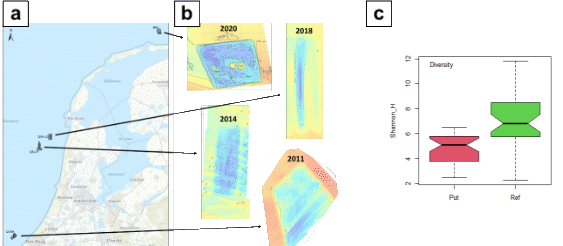S. Moons1*, R. Witbaard2, J. Craeymeersch3
1 RWS; 2 NIOZ; 3 WMR
*corresponding author:
Introduction
Coastal maintenance requires lots of sand. Where does the sand come from and what happens to the sandpits from an ecological perspective? In the Netherlands, the sand is extracted from designated offshore sites. In response to an increasing demand for sand, sandpits seem to be excavated deeper and deeper. More depth means less surface area disturbed. So, not an overall bad development for the benthic community, you would think. After the initial disturbance, benthic organisms can recolonize the bare seafloor of a shallow pit, making a full recovery within a few years. Except, as a pit becomes deeper, it seems more likely to alter the local environmental conditions. Different conditions favour different organisms; so how will the benthic community develop and will it recover fully?
Methods
Four sandpits and adjacent reference areas were selected. The time since last sand extraction differed for each pit (2011, 2014, 2018, 2020) and all were up to 6 meters deep. In early spring 2022, 71 samples were collected using the NIOZ Triple-D sledge; at least 8 samples for each pit and reference (tracklength = 50 m, ca. 10m2/track). The benthos, benthic fish and sediment was analysed.

Figure 1: (a) Sandpit location, (b) year of excavation and bathymetry (blue is deep) and (c) biodiversity.
Results
The results are startling. All pits contained a higher percentage of fine sediment and organic matter, though the amount varied greatly. All pits differed in benthic community composition from the reference areas. The pits harbour less diversity and in some cases a higher biomass and abundance of macrozoöbenthos, caused by a few dominant species. The youngest pit was recolonized quickly (within 2 years) by opportunistic benthic species, but lacked characteristic species like the sand eels that were very abundant in the reference area. The pits from 2014 and 2018 both showed much more similarity to the reference areas. Benthic species composition still differed, likely in response to the influx of fines. The oldest pit (2011) contained extremely high percentages of fines (30% average). Effects on the species composition were very apparent, favouring (sub-) surface deposit-feeders and excluding suspension feeders. This pit is likely never to recover to its original condition. The disappearance of clams and sand eels may also have a strong effect on the foodweb.
The study clearly highlights the necessity of studying the effects of sand extraction in the Netherlands and serves as a basis for future policymaking. The research report and other ongoing and planned research projects can be found online at www.zanduitzee.nl.
I. Surname1*, F.N. Another-Surname2 , Y. Next-Surname2
1 University Name, Country; 2 Organization Name, Country
* Corresponding author: mail.name@organization.org


